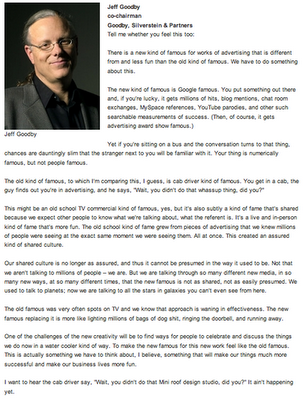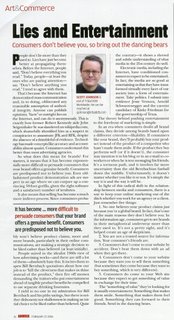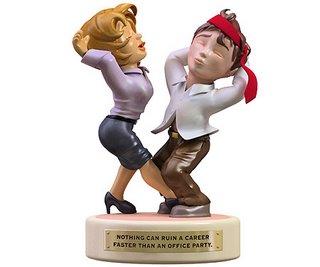 This is going to be my last post for 2006. Anybody else feel free to post. Happy Holidays everyone! -Dwen
This is going to be my last post for 2006. Anybody else feel free to post. Happy Holidays everyone! -Dwen
David Baldwin is one of the nicest and most down-to-earth advertising guys I've talked to. Even though he has a very busy schedule, he responded right away to my inquiries (refer to prior sentence). If you haven't heard of the groundbreaking Audi Art of the H3ist work, I recommend checking it out; David's agency created that. He moonlights as the part-time lead guitarist of the award-winning agency band "Pants!" and is the full-time Executive Creative Director of McKinney.
A Kelly Award-Winning copywriter, David honed his skills at Deutsch, Riney, Cole & Weber and Leonard Monahan before taking over the reins at McKinney. He’s clear on their job: “In business, the company with the biggest ideas wins. Period. It’s bigger than just doing advertising.” David is President of the One Club and on the board of the Full Frame Documentary Film Festival and the Creative Circus. David’s a graduate of The University of Texas at Austin.
How did you get in to advertising?
I’ve been a musician for most of my life and have existed in creative circles. At the same time, my mother was the media department at a small agency in El Paso, TX, where I grew up. So I guess I kind of grew up around advertising. I was certainly aware of it as a career. As a musician I was always very honest with myself about what that life would entail and I made an agreement with myself to have a back-up plan and to stop trying to make a living at music if it didn’t look like it would work out by the time I was 21. I decided advertising would be that back-up plan and enrolled at UT because I knew about the advertising program. I figured it would be a great living to be able to have a job in a creative endeavor. I finally got into the creative program and really enjoyed it and did okay at it.

Do you miss Austin? Do you miss Texas? Did you ever see yourself working In N. Carolina?
I love Austin. It’s one of the greatest cities in the world. I never saw myself living in NC but I have to say, it’s pretty wonderful. I had always admired McKinney during my career and it was a big personal achievement to be able to be the CD here.
How did UT prepare you for a career in advertising?
The creative program at the time was great because the professor was this eccentric guy named Leonard Ruben. He treated class like a job. If you were late, he locked the door. If you didn’t have an assignment ready on time, he’d literally fire you and ask you to leave. More than anyone else he impressed on me that this is a business and you have to show up.
Did you find that cutting your long hair is analogous to Samson cutting his hair?
I cut my hair because I saw myself in an agency video and thought I looked like an aging white woman. You know how you see old guys with long silver hair who really look kind of ridiculous? I always said I wouldn’t be that guy.
What's it like being the lead guitarist of the award-winning pants! (McKinney + Silver's in-house band)? I heard you play "Frampton-like vibrations on the vo-coder." Do you find that having hobbies helps the creative process?
It’s funny how life works out because I’ve managed to combine two of my passions at McKinney, advertising and music. We’re having a blast with pants! (that is the correct spelling by the way, pants! lower case ‘p’ and an exclamation point) and we have a new CD coming out this May. It was great to get to play at the Rock and Roll Hall of fame and get our picture to hang there for the year. Go figure.


Jr. CreativesWhat are the most common mistakes you observed Jr. Creatives make?First of all, I have to say that if I came into my office as I was as a jr, I’d probably kick myself out of my own office. I was clueless in so many ways. So you make allowances that kids won’t have all the answers. But there are a few general things to think about.
-Have an understanding of the industry. Who’s doing what work? Who do you admire? What are the great agencies right now? Where do you really want to work? I’m always amazed when I interview someone and they can’t answer very basic questions or have no notion of what’s going on in the business
-Thinking in ideas rather than ads. A lot of kids come in with books that have clever headlines rather than real brand ideas based on human truths. A good test of whether you have an idea or not is whether you can talk about your idea without ever having to reference the ad.
What're your favorite books/magazines?I read all the time, so I guess I’ll just talk about industry books.
-I was recently turned on to a magazine called
Contagious. It’s great.
-
The One Show-
CA-The book of
Gossage. – A book about Howard Gossage that is a must read for anyone studying or practicing the business. It’s choc full of brilliance.
-
Hey, Whipple. Squeeze this. By Luke Sullivan is one of the best how to books written about the business. It’s terrific.
-
Wired magazine.
-
Archive What separates jr. creatives in the hiring process?It’s hard to quantify but you can tell pretty fast whether someone gets it or not. It’s more important than the actual portfolio. I sometimes meet people with nice books but you can tell their hearts not really in it or they’re not burning from within. You really need a lot of passion to succeed in this business.
You must have presented hundreds of thousands of ideas to clients already. How did you learn how to present and sell your agency's ideas? Every day is a new learning experience. There’s no science to it.
I guess here are a few things to think about.
First of all, you have to be honest that we all sell all day long. When you want to see a movie that your friends don’t you’re selling. When you have a band you want your friends to listen to, you’re selling.
The best advice anyone ever gave me is to never present from opinion because as a human your first inclination is to disagree with someone selling you something. So, you know, never say, “We have an idea that’s really great….” Instead, present from the facts and let your audience make up their own mind.
Here’s a great example. (this example is from the person who gave me this advice and it’s a helpful illustration.) Say Mike is a real jerk. If you’re talking to a friend you might say, “You know, Mike is a real ass.” The person you’re talking to will listen to this and unless they have had a first hand experience with Mike they’ll immediately look to whether they should debate you or not. It’s just human nature.
Whereas if you say, ‘Did you hear what Mike did? He told those kids that they were stupid and then he sat in that old Ladies chair. He also got caught lying to his wife.” The person you’re talking to will likely say or think something like, “Wow, Mike’s a jerk.”
So when you’re presenting an idea to someone, what’s the desired response you’d like from your audience and what are the facts around your proposition that will lead to them to draw their own conclusion.
You've worked for Della Femina, Travisano & Partners, Hal Riney & Partners, Cole & Weber, Deutsch, Leonard/Monahan ranging from Rhode Island all the way to Oregon. Which cities did you like working in the most? and why?That’s kind of like trying to pick your favorite Beatles song. I’ve loved every city I’ve lived in for very different reasons.
You've had a very successful career. What are some of the highs and lows of it?The biggest highs are getting to work around and know all the people I’ve been lucky enough to meet. I have so many friends around the country and the world because of this business. The lows are not meeting up to expectations that I’ve set for myself.
Advertising in generalCan you talk about how advertising has changed from the beginning of your career to now?I got into the business the same year as the fax machine. Things were different. No computers, no avids, no internet. It’s hare to believe. The landscape has changed mightily but the thing that has stayed the same is that it’s still all about having a great idea.
What's it like being the President of the One Club Board of Directors? What does that entail?Being president of the One Club is a tremendous honor. The work their asses off. I help define policy and the make up of the board and the broader direction of the club. But the real hard work is done by Mary Warlick, Kevin Swanepoel, and the rest of the staff.
It seems like a lot of CDs are CWs. Why do you think this is? I’ve heard that before, but I’m not sure if that’s true.
McKinney+SIlverAs the ECD, you've led McKinney+Silver on a resurgence from the "bottoms of the mid-to-late '90s." What does it take for an agency to get hot and stay hot?McKinney has been a real ride for me. I joined in 1998 and two years later we were named Southeast agency of the year by Adweek. We were on a real roll. But then the CEO of the company at the time died in a car accident and that was a tough time. It seemed like my partners and my job were to hold the place together. But we’ve kind of come roaring back now. There’s always room for improvement and always a new challenge. I guess the real issue is that none of us are satisfied at all that we’ve done our best work yet or that we’ve accomplished what we’re capable of. That’s certainly what drives me.
McKinney+Silver has really put N. Carolina on the advertising map with Audi and Sony (former clients now). In the advertising world, what is N. Carolina like compared to the Londons, Berlins, Paris', Shanghais, Tokyos, Singapores, Brazils of the world?To be fair, Chick McKinney put NC on the map. I’ve only tried to continue the reputation. The first account the agency won in 1969 was for Mastercard account, then called MasterCharge. The pitch was a bunch of NY agencies and us. The real mission of this agency has always been to be a national agency located in a great place to live. We’ve never had local or regional aspirations.
What is "Carolina creativity"?I have no idea. We have people here from all over the world. I’ve always taken pride in our not having a specific style to our advertising. It has always been about communicating the brand in an authentic way. Because every brand is different the work should be different. I’ve never wanted people to know it was our work just by looking at it. I’m always perplexed when I see work that makes an agency famous rather than the brand being communicated.
PersonalWho were your advertising mentors? It's of utmost importance to have a good mentor right?I don’t know if I’ve ever really had a mentor. I suppose it would have been great to have someone really take me under their wing, but it never really happened. The best advice I ever got was to be responsible for yourself.
Is it hard going from Copywriter to Executive Creative Director? What new challenges/responsibilities does being an ECD entail?You have to realize that you have a new job. Your job is to create culture and possibility rather than to ‘write.’ I’ve always called it a transference of joy. You have to take joy from seeing someone else create a great idea and then either help make it better or get out of the way if you can’t.
Of all the work you've done, what are your personal favorites? What are your personal favorite McKinney+Silver works?I love all of my children. Even the ugly ones. I guess the real point is to learn from the things you did wrong.
As a member of the Board of Directors for The Creative Circus, what else can a portfolio program do to help prepare students? The thing I keep telling schools and students is to start teaching interactive as an equal discipline to all other media. As long as ideas are at the center it shouldn’t matter what form they take. I’m still amazed that I mostly see print books from students. It doesn’t reflect what’s going on.
What was the best advice given to you?Work really hard. That’s all there is.
Remember Tupperware? Your pantry probably overflowed with it fifteen years ago thanks to the climax of the Tupperware party—a direct marketing getup masquerading as a social event where women (and a few men?) gathered to buy brightly colored crap. Since then, companies selling other brightly colored crap (notably makeup, lingerie and sex toys) have lifted the idea and enjoyed similar results.
















































